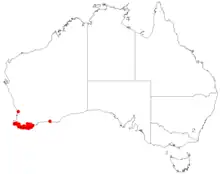| Leucopogon distans | |
|---|---|
| Scientific classification | |
| Kingdom: | Plantae |
| Clade: | Tracheophytes |
| Clade: | Angiosperms |
| Clade: | Eudicots |
| Clade: | Asterids |
| Order: | Ericales |
| Family: | Ericaceae |
| Genus: | Leucopogon |
| Species: | L. distans |
| Binomial name | |
| Leucopogon distans | |
 | |
| Occurrence data from AVH | |
| Synonyms[1] | |
| |
Leucopogon distans is a flowering plant in the family Ericaceae and is endemic to the south-west of Western Australia. It is an erect shrub that typically grows to a height of 0.2–1.2 m (7.9 in – 3 ft 11.2 in). The leaves are heart-shaped to egg-shaped or lance-shaped, 2–4.5 mm (0.079–0.177 in) long with the edges rolled under. The flowers are arranged in spikes on the ends of branches or in upper leaf axils, the flowers well-spaced from each other, with small bracts and broad bracteoles at the base. The sepals are about 4 mm (0.16 in) long, the petal tube about the same length as the sepals, the lobes about twice as long. Flowering occurs from July to February.[2][3]
Leucopogon distans was first formally described in 1810 by Robert Brown in his Prodromus Florae Novae Hollandiae.[4][5] The specific epithet (distans) means "distant", referring to the well-spaced flowers.[6]
This leucopogon grows on sandy and gravelly soils in swamps, sandplains and hills in the Esperance Plains, Jarrah Forest and Warren bioregions of south-western Western Australia.[2]
References
- 1 2 "Leucopogon distans". Australian Plant Census. Retrieved 13 August 2022.
- 1 2 "Leucopogon distans". FloraBase. Western Australian Government Department of Biodiversity, Conservation and Attractions.
- ↑ Bentham, George; von Mueller, Ferdinand (1868). Flora Australiensis. Vol. 4. London: Lovell Reeve & Co. p. 189. Retrieved 18 July 2022.
- ↑ "Leucopogon cucullatus". APNI. Retrieved 18 July 2022.
- ↑ Brown, Robert (1810). Prodromus Florae Novae Hollandiae. London. p. 544. Retrieved 13 August 2022.
- ↑ Sharr, Francis Aubi; George, Alex (2019). Western Australian Plant Names and Their Meanings (3rd ed.). Kardinya, WA: Four Gables Press. p. 185. ISBN 9780958034180.